Searching for an ideal Andalucían ‘fixer-upper’
Friday, August 21, 2015
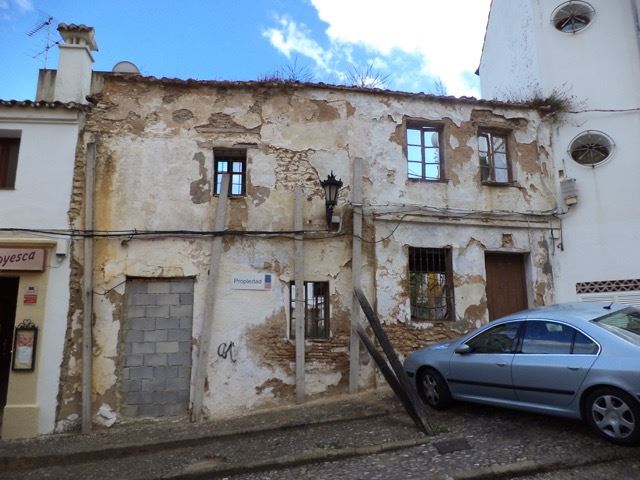 Whenever I travel, and wherever, I always think “Imagine living here!” Be it a Mexican city of millions, a dusty market town in Rajasthan, Venice Beach, a Tibetan refugee settlement or an island off the Oregon coast, I always seem to find a dream home and want to move in. (Blame those ‘sail, raid and settle’ Viking roots of mine) As was to be expected, the same thing happened when we first visited Andalucía. Not that we were looking to buy anything, nor could we have guessed that we were to come back to live here. However, my head started churning and my keenly developed ‘fixer-upper’ gene went into overdrive. Just seeing all those tempting stone ruins and ramshackle barns in perfect state of decay. Whenever I travel, and wherever, I always think “Imagine living here!” Be it a Mexican city of millions, a dusty market town in Rajasthan, Venice Beach, a Tibetan refugee settlement or an island off the Oregon coast, I always seem to find a dream home and want to move in. (Blame those ‘sail, raid and settle’ Viking roots of mine) As was to be expected, the same thing happened when we first visited Andalucía. Not that we were looking to buy anything, nor could we have guessed that we were to come back to live here. However, my head started churning and my keenly developed ‘fixer-upper’ gene went into overdrive. Just seeing all those tempting stone ruins and ramshackle barns in perfect state of decay.
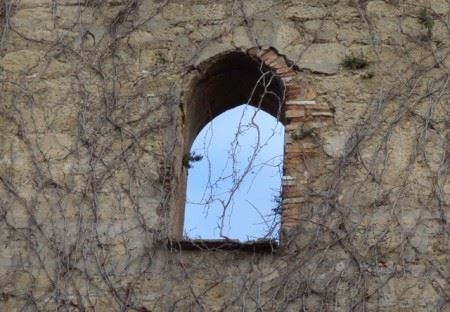 When my husband retired and we returned to Andalucía for an open-ended sabbatical, it did not take many days before we both started dreaming about ‘our’ private little slice of Andalucían paradise. We were still Canadians (my husband a citizen, myself a permanent resident) but we felt that it would not hurt to look around. Who would not want to have a small pied-à-terre in southern Spain? With almost unlimited time on our hands and a Virgo in the family (the before-mentioned spouse), we started doing research and making lists of areas of interest. Fortuitously we wanted more or less the same thing; a charming Andalucian town, not completely overrun by expats, situated reasonably close to an international airport, with proximity to nature, an ample selection of cafes and a few shady town squares, art, culture and history and last but not least, a friendly local community. When my husband retired and we returned to Andalucía for an open-ended sabbatical, it did not take many days before we both started dreaming about ‘our’ private little slice of Andalucían paradise. We were still Canadians (my husband a citizen, myself a permanent resident) but we felt that it would not hurt to look around. Who would not want to have a small pied-à-terre in southern Spain? With almost unlimited time on our hands and a Virgo in the family (the before-mentioned spouse), we started doing research and making lists of areas of interest. Fortuitously we wanted more or less the same thing; a charming Andalucian town, not completely overrun by expats, situated reasonably close to an international airport, with proximity to nature, an ample selection of cafes and a few shady town squares, art, culture and history and last but not least, a friendly local community.
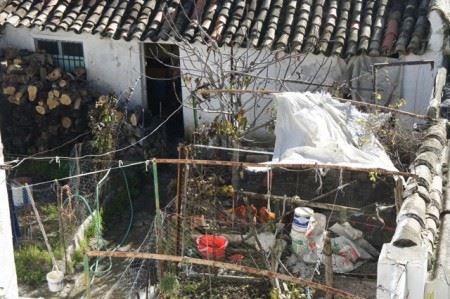 Looking for a new hometown on the Internet is quite different for seeing it with ones own eyes. And ears. A town might seem ever so idyllic in photos, but when you get there you might realize that it is located right along a noisy highway. You might believe you have found your Nirvana, until you discover that there is a single windy road to get out of town with an hour-long drive to the next human development. Not an issue if you are looking for utter isolation or are writing a doctorate on dung beetles, but we instantly knew when we got there that these types of places were not for us. A lovely photogenic village might upon closer inspection have too many vagrant dogs to allow one to go for a peaceful afternoon stroll, it may suffer from water shortage if another golf course construction gets green-lighted, or it may be that the local residents just don’t give you that warm and fuzzy feeling. There are so many details one cannot pick up on online. Certainly not from real estate sites whose descriptions tend to omit less desirable facts. Looking for a new hometown on the Internet is quite different for seeing it with ones own eyes. And ears. A town might seem ever so idyllic in photos, but when you get there you might realize that it is located right along a noisy highway. You might believe you have found your Nirvana, until you discover that there is a single windy road to get out of town with an hour-long drive to the next human development. Not an issue if you are looking for utter isolation or are writing a doctorate on dung beetles, but we instantly knew when we got there that these types of places were not for us. A lovely photogenic village might upon closer inspection have too many vagrant dogs to allow one to go for a peaceful afternoon stroll, it may suffer from water shortage if another golf course construction gets green-lighted, or it may be that the local residents just don’t give you that warm and fuzzy feeling. There are so many details one cannot pick up on online. Certainly not from real estate sites whose descriptions tend to omit less desirable facts.
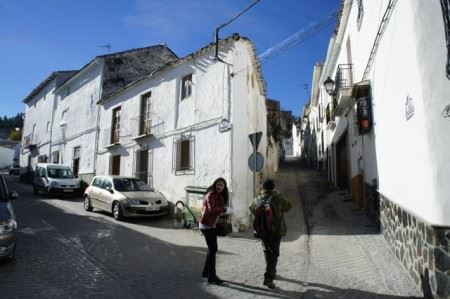
The size of the town is something equally important to consider. We had lived in too many cosmopolitan cities and knew that we wanted a small town. But how small is small before it gets claustrophobic? How is your tolerance for village gossip? Is a single café enough to fulfill your gourmet and social needs? Or do you need a theatre, concerts and high speed Internet to be happy? Are train and bus service vital for you to get around? Does schools or other family services play a part in your decision? What about a medical specialist or a notary who speaks English? And can you live without a decent hair stylist?
We figured out that our ideal town should be less than 100 000 inhabitants, yet certainly have more than 25 000 residents, allowing for at least a couple of commercial streets and a small selection of cafés and bars. We have friends who have bought picture-perfect fincas, surrounded by unlimited vistas of rolling hills and olive groves. To be located miles from the next town may seem like heaven, until you realize that you have to jump in the car to go and buy bread. And God forbid if you should need a hospital…
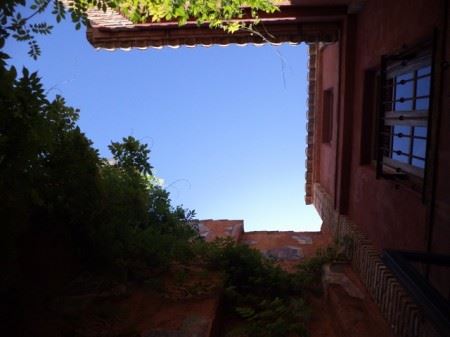 The house itself is a whole other matter. Spain has literally millions of properties available so one has to narrow down ones search. Do you want a flat or a house, free standing or attached, a tiny balcony, a good-sized garden or an entire vineyard? Do you want something ready to move into or do you wish to renovate? Clearly everyone has different needs, budgets and dreams. One can find huge homes for virtually giveaway prices especially on the coast, but one may end up living in a ‘ghost community’ all the neighbouring houses are for sale or simply abandoned. You can even buy a whole village now, just be sure to bring your friends along or you will be very lonely. With so many considerations to take it behoves one to look into them before making any purchases or signing any papers. The house itself is a whole other matter. Spain has literally millions of properties available so one has to narrow down ones search. Do you want a flat or a house, free standing or attached, a tiny balcony, a good-sized garden or an entire vineyard? Do you want something ready to move into or do you wish to renovate? Clearly everyone has different needs, budgets and dreams. One can find huge homes for virtually giveaway prices especially on the coast, but one may end up living in a ‘ghost community’ all the neighbouring houses are for sale or simply abandoned. You can even buy a whole village now, just be sure to bring your friends along or you will be very lonely. With so many considerations to take it behoves one to look into them before making any purchases or signing any papers.
We wanted a fairly small home. Something easy to maintain and quick to lock up when we want to go travelling, with lots of light and windows, ideally a big terrace to grow an olive tree and a nice quiet street. As we started our home search, I began taking photos of ruins and teardowns. To assure that my aging parents’ hearts were kept strong, I would send the worst photos to them saying we had found our dream home. Those half fallen down walls? No problem, I would learn stone masonry. And my husband would fix that collapsed roof in a jiffy. There was of course a secondary purpose to me sending the photos, as I hoped that once we found our dream place, it would not actually seem so daunting for my old folks.
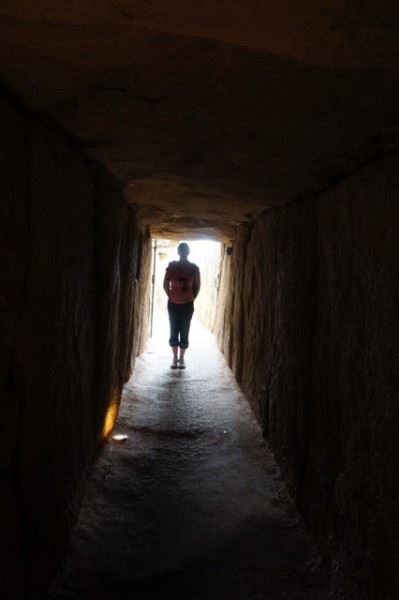 As we started viewing properties, we realized that for our particular case we were better off buying ‘a wreck’ and building from scratch than taking on somebody else’s building project. Having spent my career designing film sets and making TV interiors, I love converting spaces. An occupational hazard so to speak. Added to this, the southern Spanish style is almost polar-opposite to my more subdued Scandinavian taste. At the risk of making gross generalizations and knowing that I am certainly not the judge of what is de mauvais gout, I have made the following observations. People in rural Andalucia (and elsewhere in small-town Spain) tend to like dark woods, ideally amply carved. They tend to fill their home to bursting with heavy furniture and drapery. They love to use a combination of multi-coloured Arab wall tiles and may top the design off with a sweeping white marble staircase if they can afford it. Just as my sparse and somewhat industrial taste seem outlandish and unfinished to many of our neighbours, the Andalucían love for brown kitchens may seem drab and depressing to me. There are of course many stunning exceptions and lovely Spanish building styles. However, at the price range we could afford and in the types of neighbourhoods we were looking, the brown on brown was the general style going. Buying a renovated place would probably mean bringing in the bulldozer. In other words, we were in the market for a teardown. As we started viewing properties, we realized that for our particular case we were better off buying ‘a wreck’ and building from scratch than taking on somebody else’s building project. Having spent my career designing film sets and making TV interiors, I love converting spaces. An occupational hazard so to speak. Added to this, the southern Spanish style is almost polar-opposite to my more subdued Scandinavian taste. At the risk of making gross generalizations and knowing that I am certainly not the judge of what is de mauvais gout, I have made the following observations. People in rural Andalucia (and elsewhere in small-town Spain) tend to like dark woods, ideally amply carved. They tend to fill their home to bursting with heavy furniture and drapery. They love to use a combination of multi-coloured Arab wall tiles and may top the design off with a sweeping white marble staircase if they can afford it. Just as my sparse and somewhat industrial taste seem outlandish and unfinished to many of our neighbours, the Andalucían love for brown kitchens may seem drab and depressing to me. There are of course many stunning exceptions and lovely Spanish building styles. However, at the price range we could afford and in the types of neighbourhoods we were looking, the brown on brown was the general style going. Buying a renovated place would probably mean bringing in the bulldozer. In other words, we were in the market for a teardown.
We had looked far and wide for a home to our taste and our wallet size when one day we discovered that the house right next door to our rental property was for sale. It was tiny. It was crocked. It was old. The roof was about to fall in. “Imagine living here,” I thought. We had finally found our dream casita!
To read what happened next, check out my upcoming blog ‘Our 3-meter wide slice of Andalucian paradise’.
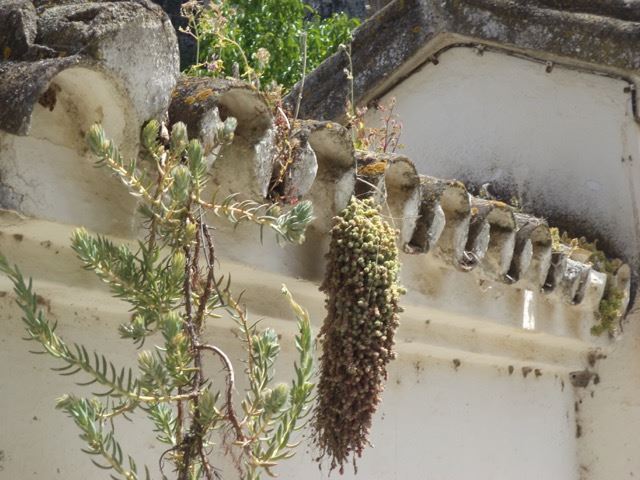
 1
Like
Published at 6:37 PM Comments (0)
1
Like
Published at 6:37 PM Comments (0)
Steady hands! Cleaning the feet of a 350-year-old baby Jesus
Sunday, August 9, 2015
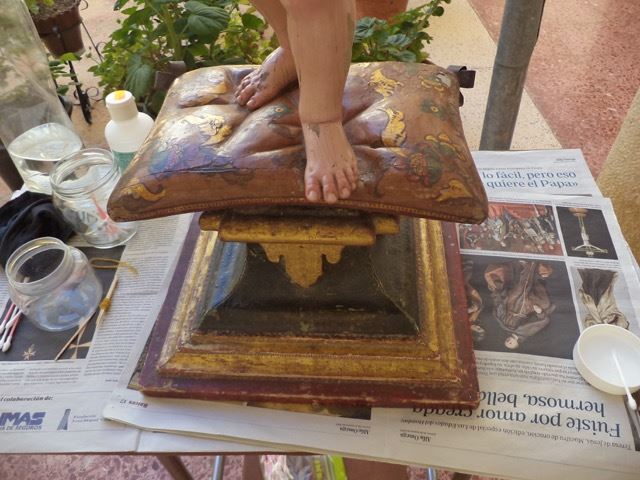
Any legitimate antique restorer or person who has dabbled in furniture restoration (the latter of whom I belong) have heard about Ecce Homo, one of the most catastrophic attempts at restoration, as well as one of the most virally successful faux pas of all time.
Ecce Homo, in case anyone wonders, is a religious fresco of Christ by the 19.th century Spanish painter Elías García Martínez. It was hanging in the Santuario de Misericordia in the town of Borja in Zaragoza for almost a century without any worldly recognition. Then in 2012, an 81-year-old parishioner and self proclaimed artist decided to ‘fix’ it because she was upset by it’s peeling paint. The result may have been an artistic travesty, but it certainly was a welcome blooper for the news-hungry worldwide web. The Before and After pictures (see below) prompted international mockery. A flaked, but genuine and moving portrait turned into an altogether altered Jesus, whose facial hair looked like a pelt, with beadlike, shifty eyes and a drooping mouth smeared over by the ‘alternist’. One can assume she hadn’t gotten to fix that part yet, as she later claimed that she hadn’t finished her work on it (when she was so rudely interrupted…).
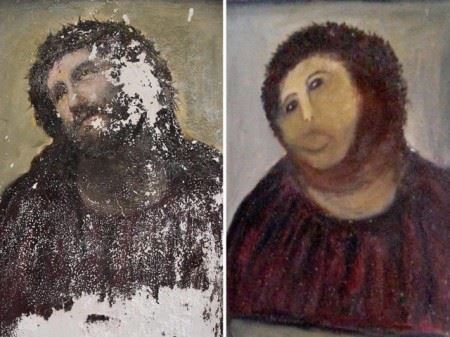 The story does not end there. The poor restoration has inadvertently provided a massive boost to Borja, making this once insignificant village a popular tourist destination. People from all over are flocking to see Ecce Homo. Legal action against the ‘artist’ was proposed, as well as trying to peel back layers of over-painting to restore Christ to his original state, but the so-far 150 000 people who has paid the entrance fee to see the ruined fresco naturally put it on the back burner. Meanwhile, the artist had a nervous breakdown due to the media hype, then proceeded to require for royalties for her ‘handiwork’ from the visitor fees, so she could give them on to her chosen charity. A celebrity of sorts, the restorer is credited with the stabilization of the local economy. Her own paintings are now growing in appeal, especially with the ones of a rather macabre taste. The latest is the NY (Off Broadway??) comic opera about the unfortunate fresco. I am sure it will be a raving success. As the director claimed, “God works in mysterious ways.” The story does not end there. The poor restoration has inadvertently provided a massive boost to Borja, making this once insignificant village a popular tourist destination. People from all over are flocking to see Ecce Homo. Legal action against the ‘artist’ was proposed, as well as trying to peel back layers of over-painting to restore Christ to his original state, but the so-far 150 000 people who has paid the entrance fee to see the ruined fresco naturally put it on the back burner. Meanwhile, the artist had a nervous breakdown due to the media hype, then proceeded to require for royalties for her ‘handiwork’ from the visitor fees, so she could give them on to her chosen charity. A celebrity of sorts, the restorer is credited with the stabilization of the local economy. Her own paintings are now growing in appeal, especially with the ones of a rather macabre taste. The latest is the NY (Off Broadway??) comic opera about the unfortunate fresco. I am sure it will be a raving success. As the director claimed, “God works in mysterious ways.”
So, what does Ecce Homo have to do with my story? Nothing really, if it had not been for the mother superior of our local convent sending a message to ask if I could help them with a restoration project. Immediately thinking of Ecce Homo, I prayed it would be a broken chair and not a 500-year-old painting of a Madonna. I went and saw ‘our’ nuns and the madre told me how grateful they were that I could have a look at their restoration piece. Sor Clara, one of the more swift-moving sisters was asked to go and show me the object, me still hoping for that three-legged chair, dreading the century old canvas of a virgin…
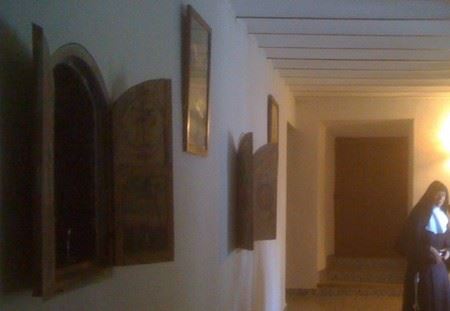 Sor Clara brought me up some stairs, passing several carved and painted niches. She stopped at one of these, the content of which they wanted me to fix. It was a statue of baby Jesus standing on a plinth, about 50 cm tall. The baby had curiously adult features the way one see in old religious paintings. Sor Clara and I brought the treasure carefully down the stairs and into the nun’s official visitation room. Madre, now joined by Sor Nieve(sister Snow) was waiting, anxious to hear my most sought-after opinion. I told them immediately that I am not a professional restorer, simply someone who enjoys fixing old things, primarily broken and worm-ridden farm furniture. I asked them how old they thought the statue was, and they said it was about 350 years old. Three hundred and fifty! Even if their estimation was off by a few decades, I could see the uproar. Ecce Homo was barely hundred years old and he was an adult Jesus. This was an innocent baby! Knowing the devoted Catholics of Ronda, I would be lynched, tarred and excommunicated if I as much as made a single nick on their baby. And the last thing I wanted was a Ronda sequel of the Ecce Homo affair… Sor Clara brought me up some stairs, passing several carved and painted niches. She stopped at one of these, the content of which they wanted me to fix. It was a statue of baby Jesus standing on a plinth, about 50 cm tall. The baby had curiously adult features the way one see in old religious paintings. Sor Clara and I brought the treasure carefully down the stairs and into the nun’s official visitation room. Madre, now joined by Sor Nieve(sister Snow) was waiting, anxious to hear my most sought-after opinion. I told them immediately that I am not a professional restorer, simply someone who enjoys fixing old things, primarily broken and worm-ridden farm furniture. I asked them how old they thought the statue was, and they said it was about 350 years old. Three hundred and fifty! Even if their estimation was off by a few decades, I could see the uproar. Ecce Homo was barely hundred years old and he was an adult Jesus. This was an innocent baby! Knowing the devoted Catholics of Ronda, I would be lynched, tarred and excommunicated if I as much as made a single nick on their baby. And the last thing I wanted was a Ronda sequel of the Ecce Homo affair…
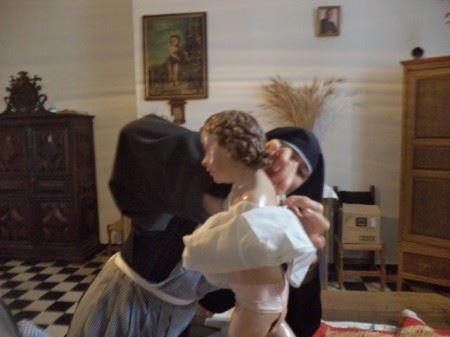 I observed the statue closer. The figure and its base had obvious damages and miscolouring, in addition to having a lot of wax droppings from centuries of annual Christmas masses and Easter processions. I asked the sisters to carefully undress him, so I would not be the first one to break off his arm or unburden him of a finger. The outer robe was newer (I dare say in some synthetic fiber), but as we peeled off yet another white gown, the fabric and the embroidered edge got finer and more delicate, until finally we had him down to his century-old peach-coloured loincloth. I observed the statue closer. The figure and its base had obvious damages and miscolouring, in addition to having a lot of wax droppings from centuries of annual Christmas masses and Easter processions. I asked the sisters to carefully undress him, so I would not be the first one to break off his arm or unburden him of a finger. The outer robe was newer (I dare say in some synthetic fiber), but as we peeled off yet another white gown, the fabric and the embroidered edge got finer and more delicate, until finally we had him down to his century-old peach-coloured loincloth.
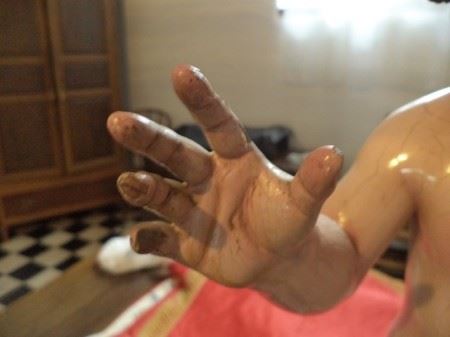 Curiously, baby Jesus, like other young children, had dirt in the places that most kids gets grimy; between his toes, on his hands, behind his knees, in the ears etc. In addition to the dirt, he had a big crack running along his face, and several places where he was lacking paint. I told the nuns that I would do what I could to help them, yet not promising anything. They were all content, saying that their baby Jesus would be ‘like new’ after I would be done with him. Absolutely Not!, I said. They should not wish him to become new. He is lovely as he is with his scars of time. I said that I could carefully try to clean the dirt of him, but I would not touch the paint. If they wanted somebody to repaint him, they would have to look for professional help. To me, a complete restoration would ruin the statue. Curiously, baby Jesus, like other young children, had dirt in the places that most kids gets grimy; between his toes, on his hands, behind his knees, in the ears etc. In addition to the dirt, he had a big crack running along his face, and several places where he was lacking paint. I told the nuns that I would do what I could to help them, yet not promising anything. They were all content, saying that their baby Jesus would be ‘like new’ after I would be done with him. Absolutely Not!, I said. They should not wish him to become new. He is lovely as he is with his scars of time. I said that I could carefully try to clean the dirt of him, but I would not touch the paint. If they wanted somebody to repaint him, they would have to look for professional help. To me, a complete restoration would ruin the statue.
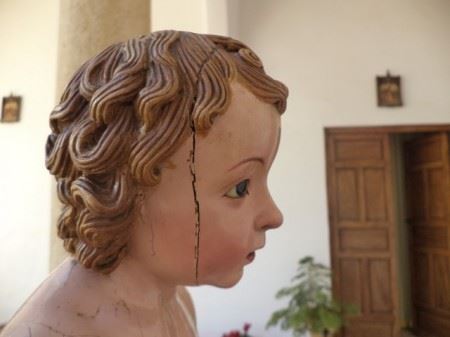 As I knew that the old baby Jesus would fare badly with an unnecessary trip across the San Fransisco plaza to our restoration workshop, I brought my restoration teacher, ironically named María Jesus, to see the statue instead. She agreed with me fully, and told the nuns that it was a real treasure. There was nobody in our town, she said, who could do this type of fragile restoration, not that she would dare to recommend anyhow. Ronda has many wood carvers and gilders who are excellent at what they do, but this statue needed a top-notch restoration painter and when it comes to that one has to look to Cordoba, Granada or Sevilla. As I knew that the old baby Jesus would fare badly with an unnecessary trip across the San Fransisco plaza to our restoration workshop, I brought my restoration teacher, ironically named María Jesus, to see the statue instead. She agreed with me fully, and told the nuns that it was a real treasure. There was nobody in our town, she said, who could do this type of fragile restoration, not that she would dare to recommend anyhow. Ronda has many wood carvers and gilders who are excellent at what they do, but this statue needed a top-notch restoration painter and when it comes to that one has to look to Cordoba, Granada or Sevilla.
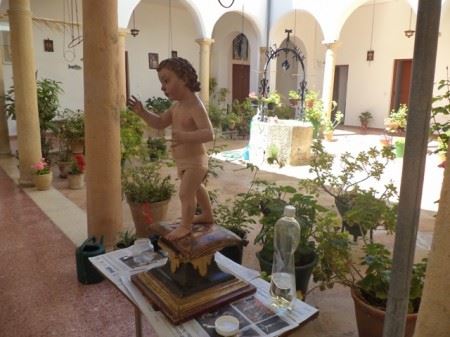 The next few days I went to the nunnery to perform my volunteer job as a Jesus cleaner. The nuns let me pick my work spot and found me a worktable that we placed in one of their lovely blossoming courtyards. We also went up to their stash of clothing for the poor to find some cotton T-shirts that I ripped into shreds and used as cleaning cloths. I brought a couple of liquids, recommended by my teacher, and started carefully cleansing the surface of dirt, millimeter by millimeter. The object is to do it without bringing up paint or dissolving the old varnish which protects it and gives it its lovely old gleam. With Q-Tips and Japanese toothpicks as my primary tools, I managed to unearth some of its original colour and rid the young lad of a not-insignificant amount of candle wax from his blond locks. Of course, at the time when this statue was made, it was generally believed that an angelic creature like this must be blue-eyed and golden haired, in spite of that the subject in question was Middle Eastern. The next few days I went to the nunnery to perform my volunteer job as a Jesus cleaner. The nuns let me pick my work spot and found me a worktable that we placed in one of their lovely blossoming courtyards. We also went up to their stash of clothing for the poor to find some cotton T-shirts that I ripped into shreds and used as cleaning cloths. I brought a couple of liquids, recommended by my teacher, and started carefully cleansing the surface of dirt, millimeter by millimeter. The object is to do it without bringing up paint or dissolving the old varnish which protects it and gives it its lovely old gleam. With Q-Tips and Japanese toothpicks as my primary tools, I managed to unearth some of its original colour and rid the young lad of a not-insignificant amount of candle wax from his blond locks. Of course, at the time when this statue was made, it was generally believed that an angelic creature like this must be blue-eyed and golden haired, in spite of that the subject in question was Middle Eastern.
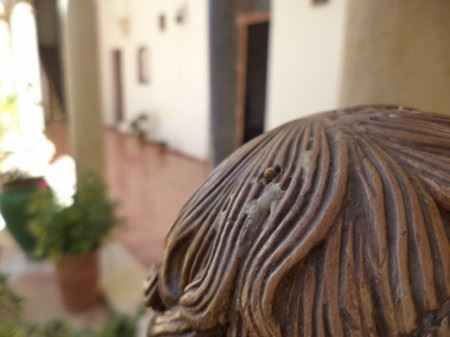 Cleaning ‘my’ baby Jesus in in the courtyard in peace and serene calm, I was almost ready to sign up for the order. At least I could see the attraction of this life. Though of course while spending hours working on a dirty fingernail, a stubborn ear canal spot or an especially grimy toe, one cannot help but also overhear the more everyday shall we say squabbling of the nuns as they patiently go on with their monastic life. Cleaning ‘my’ baby Jesus in in the courtyard in peace and serene calm, I was almost ready to sign up for the order. At least I could see the attraction of this life. Though of course while spending hours working on a dirty fingernail, a stubborn ear canal spot or an especially grimy toe, one cannot help but also overhear the more everyday shall we say squabbling of the nuns as they patiently go on with their monastic life.
One day upon my arrival, the priest was there. He told me that they had decided to send Jesus to a professional restorer in Seville. The nuns regretted it profusely, as though I was not the one who immediately told them that this was a job for a professional. Sor Nieve told me that they wanted to also send the virgin in the hall, who seem to have mysteriously developed a maquillage-ed and rose-coloured complexion. Virgins, as we all know, are supposed to be pure white. Why not send her along for a two for one mother/son deal, I thought, but did not say out loud.
My work with Baby Jesus ended with cleaning his toes, and having read the bible many moons ago, I know I should be honoured. And I am! I am trilled to have been allowed to be part of the journey to restore baby Jesus back to health. It is rather ironic that they would ask me to help, a nordic heathen, neither Catholic nor Christian. But I am always glad to help, and I love history, art and antiques. I would volunteer again in a heartbeat if I were asked to clean a statue of Krishna, an imprint of Buddha’s foot, a marble carving from the Koran or a Viking ship. Not that anyone will be crazy enough to ask me…
(For more Anfdalucian stories, please go to www.snobb.net)
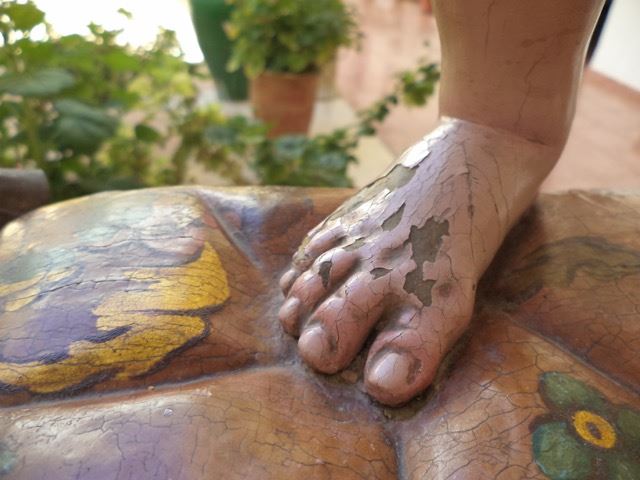
 0
Like
Published at 4:51 PM Comments (1)
0
Like
Published at 4:51 PM Comments (1)
Is it the heat or was that mountain talking to me?
Sunday, August 2, 2015
A lot can be said about the Spanish heat and when one lives in Andalucía, people never seem to tire of the subject. Just as they stop bemoaning ‘que frío’ (What a cold!) far into our balmy spring, they start whining about ‘que calor!’ (What heat!), until they re-start complaining about the cold again in the fall.
However, these days they might have a point. Our thermometer have been soaring into the mid-forties for nearly six weeks even here in our usually rather ‘fresquito’ mountain village. Heat wave after heat wave (usually blamed on Africa, not Global Warming…) have been overlapping without a single nights’ repose. Even the oldest of Ronda residents say that this is not normal. If you are foolish enough, and foolish one do get in this heat, to leave your car in the sun to pop in for a quick errand to replenish your all-important ice supply, you will come back to a literal frying pan of over 50 degrees. Celsius, that is. One is best advised to keep out of the heat and only venture in the early morning or late night. But, when the mountains are calling, one sometimes has to make an exception…
The other day my husband and I decided to visit the famous El Torcal near the town of Antequera in Malaga province. We had seen pictures of the hoodoo-like landscape and were keen to explore it ourselves. Driving into Antequera, El Torcal is located 12 km up a winding road, ending at an otherworldly plateau at about 1100 meters. Arriving during siesta hour when no Spaniards wish to be stirring, we decided to start with lunch at the café, while overlooking the amazing landscape.
El Torcal Nature Reserve is said to be one of the most impressive limestone landscapes in all of Europe. The Jurassic age stone, some 150 million years old, spent its first millennia under water. Movements of the earth trusted the sea beds into mountains, which then rain and wind eroded and chiseled away at for further millions of years, forming some most incredible shapes.
Not being ones to back away from challenges, we left a few visiting families with cokes and ice creams and sat out in the 40-plus-degree heat to explore this enchanted landscape, bellies full and water bottles in hand. The Torcal trails are frequently sign posted and well made and meander harmoniously through valley after valley of sculpted rocks. Not surprisingly in this heat we only saw two other individuals on our walk, though they might of course have been a mirage?
As one spends most of ones time staring UP in utter disbelief and jaw-dropping amazement at the troll-faced rocky outcrops while handing oneself blindly along and only intermittently peaking down to catch ones bearings, one cannot avoid but getting completely lost in time and space. They say that the furthest walk, which is only about 4,5 km long, takes 3 hours, though we must have spent an eternity. Time becomes a daze. The upwards gaze also is conducive to taking a wrong path and coming to one of many dead ends, so after being lost at least twice in spite of said signage, we ran into one of the resident wild goats with her offspring. They were clearly used to human explorers, staring at us with an ‘I wasn’t expecting you people until after the siesta’ look.
Like being in Monument Valley, possibly on acid, we started feeling that peering eyes from above observed us. Haughty eagle heads topped cliffs and flat nosed gangsters seemed to holler across the valley to yet another shady rock figure. We even passed a whole jury, all clad in stone. It would take the most cynic of minds not to see mythical beings with giant noses coming out of these rocks. Some have actually been given official names, such as the Sphinx, the Jug and the famous Camel. The further on one ventures, and possibly the hotter it gets, the more the mountains come alive.
They say that the best things in life are free, and that is certainly true of El Torcal. If our visit was at high noon, I can just imagine how fantastically eerie it must be to explore these rocks alone on a foggy November eve. (For more information on El Torcal, please go to: http://torcaldeantequera.com/)
By SNOBB.NET
 0
Like
Published at 6:17 PM Comments (0)
0
Like
Published at 6:17 PM Comments (0)
Spam post or Abuse? Please let us know
|
|